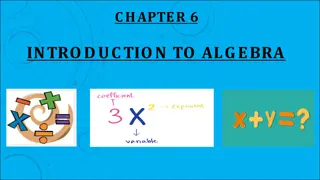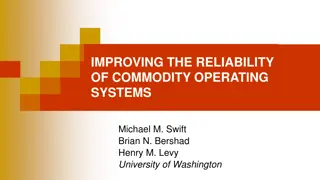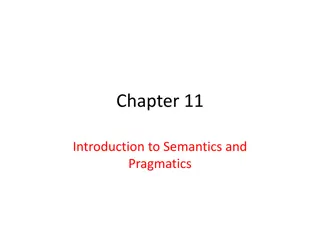Understanding Field Extensions in Algebra
Exploring the concepts of rings, fields, and field extensions in algebra, focusing on the definitions, properties, and examples. Learn about the Main Theorem for simple field extensions, as well as what to do if a field extension is not simple.
Download Presentation

Please find below an Image/Link to download the presentation.
The content on the website is provided AS IS for your information and personal use only. It may not be sold, licensed, or shared on other websites without obtaining consent from the author. Download presentation by click this link. If you encounter any issues during the download, it is possible that the publisher has removed the file from their server.
E N D
Presentation Transcript
OUTLINE - - Rings - Fields - Field Extensions - Algebraic - Minimal Polynomials Definitions Definitions - First Isomorphism Theorem First Isomorphism Theorem - Main Theorem(for simple field extensions) Main Theorem(for simple field extensions) - Example of Main Theorem Example of Main Theorem - What if my field extension is not simple?! What if my field extension is not simple?!
WHAT IS A RING ? A A ring ring is a set R equipped with two binary operations called addition and multiplication is a set R equipped with two binary operations called addition and multiplication such that: such that: - - (R,+) is an (R,+) is an abelian abelian (commutative) group (commutative) group - - (R, x) has the following properties: (R, x) has the following properties: - - Closed Closed - - Associative Associative - - There is a multiplicative identity 1 There is a multiplicative identity 1 - - Multiplication distributes over the addition Multiplication distributes over the addition Examples: Examples: - -Z , Z Z , Z4 4, R , Q , R , Q
WHAT IS A FIELD ? A A field field is commutative ring whose nonzero elements form a group under is commutative ring whose nonzero elements form a group under multiplication multiplication So a So a field inverse inverse field is commutative ring whose nonzero elements each have a multiplicative is commutative ring whose nonzero elements each have a multiplicative Examples: Examples: - - Z Zp pwhere p is prime, R, Q, C where p is prime, R, Q, C Non Non- -examples: examples: - - Z Zn nwhere n is not prime where n is not prime
WHAT IS A FIELD EXTENSION ? Let K be a field. If a set k Let K be a field. If a set k K is closed under the field operations and inverses in K (i.e. K is closed under the field operations and inverses in K (i.e. k is a subfield of K) then we call K an extension field of k. We say K/k, K over k, is k is a subfield of K) then we call K an extension field of k. We say K/k, K over k, is a a field extension field extension. . Example: Example: - - R and Q are both fields where Q R and Q are both fields where Q R. Therefore, R is an extension field of Q. We R. Therefore, R is an extension field of Q. We could state this as: R/Q is a field extension. The same relationship holds for R could state this as: R/Q is a field extension. The same relationship holds for R C. C. Extension field of R ? ? Extension field of Q and Subfield of C ? Subfield of R
CONSTRUCTING AN EXTENSION FIELD Consider a base field k. Adjoin with it an element Consider a base field k. Adjoin with it an element k to construct k( field that contains the base field k and also field that contains the base field k and also . . k to construct k( ), the smallest ), the smallest Example: Example: - - If we start with the field Q, we can build the field extension Q( 2)/Q by adjoining If we start with the field Q, we can build the field extension Q( 2)/Q by adjoining 2 to Q where Q( 2) = {a + b 2 | a, b 2 to Q where Q( 2) = {a + b 2 | a, b Q} is an extension field. Q} is an extension field. Note: we call any extension of the form k( Note: we call any extension of the form k( ) a element is adjoined. element is adjoined. ) a simple simple extension field because only one extension field because only one ?( 2) Extension Field (K K) ? Subfield (k k)
WHAT IS AN ALGEBRAIC ELEMENT ? If K is a field extension of k, then an element If K is a field extension of k, then an element K is called exists some non exists some non- -zero polynomial g(x) zero polynomial g(x) k[x] such that g( K is called algebraic over k algebraic over k if there k[x] such that g( ) = 0. ) = 0. if there Example: Example: - - Consider Q( 2), an extension field of Q. 2 is algebraic over Q since it is a root of Consider Q( 2), an extension field of Q. 2 is algebraic over Q since it is a root of ?? ? Q[x]. Q[x]. Non Non- -Example: Example: - - Consider Q( Consider Q( ). ). is a root of x algebraic over Q. algebraic over Q. is a root of x , but this polynomial is , but this polynomial is not not in Q[x]. So, in Q[x]. So, is not is not
WHAT IS A MINIMAL POLYNOMIAL ? Let Let K be algebraic over k. The K be algebraic over k. The minimal polynomial k[x] of k[x] of least degree least degree such that p( such that p( ) = 0. minimal polynomial of ) = 0. of is the is the monic monic polynomial p polynomial p Proposition: The minimal polynomial is irreducible over k and any other non Proposition: The minimal polynomial is irreducible over k and any other non- -zero polynomial f(x) such that f( polynomial f(x) such that f( ) = 0 must be a multiple of p. ) = 0 must be a multiple of p. zero Example: Example: = 2 element of Q( 2) where 2 is algebraic over Q. The minimal polynomial of = 2 element of Q( 2) where 2 is algebraic over Q. The minimal polynomial of 2 is 2 is ?? ?.
WHAT ARE QUOTIENT RINGS ? A A quotient ring quotient ring is constructed out of a given ring R by a process of is constructed out of a given ring R by a process of moding ideal I ideal I R, denoted R/I. R, denoted R/I. moding out by an out by an Ex.1 Ex.1 ?/ ? ?? In general, In general, ?/ ? ?? Ex.2 Ex.2 ? ? / ??+ ? ? where where ??+ ? is the ideal is the ideal Note, when you have a principal ideal, it is generator is the minimal polynomial Note, when you have a principal ideal, it is generator is the minimal polynomial
CONSEQUENCE OF THE FIRST ISOMORPHISM THEOREM Given K/k, with Given K/k, with ? ? algebraic over k and the minimal polynomial algebraic over k and the minimal polynomial ? of the homomorphism the homomorphism of ?, consider , consider ?:? ? ? ? x x ? N N???: ker ? = ? By the First Isomorphism Theorem, By the First Isomorphism Theorem, ? ? / ? ?(?) Kernel Range Domain
Given K = k(), with algebraic over k, how do we compute the minimal polynomial of any K ? Main Theorem: Main Theorem: Let K/k be a field extension, and let K be algebraic over k. Let ? ?[?] be the minimal polynomial of over k. Let 0 ? k( ), say ??+ ?1? + + ???? ?0+ ?1? + + ???? where ??,?? ?,0 ? ?,0 ? ?. Let ? ? = ??+ ?1? + + ???? and ?(?) = ?0+ ?1? + + ???? be the corresponding polynomials in ?[?]. Consider the ideal ? =< ?,?? ? > of ?[?,?]. Then the minimal polynomial of ? over k is the monic polynomial that generates the ideal ? ? ? . ? = Note: since ? ? / ? ?(?), we can compute in ? ? / ?
Proof. Since ?[?]/ ? is a field and ? ? 0, there is a polynomial ? ? ? such that ?? 1 (??? ? ) that is ?? 1 ? Let = ??. Note that ? = ?. ?(?) Now consider the map ? ? ? ? ? / ? ? + ? ? ? is in the kernel of ? if and only if ? ? = 0. Therefore, the minimal polynomial of ? will be in the kernel of ?. We now find the generator of the kernel of We now find the generator of the kernel of ? because this will be minimal polynomial !!! this will be minimal polynomial !!! because
By another theorem, the kernel of ? is ?,? ?[?]. Recall that we are considering the ideal ? =< ?,?? ? >. So, if we can show ?,? =< ?,?? ? > then we know that the kernel of the map ? is ?,?? ? ?[?], namely the minimal of ? is the monic polynomial that generates the ideal ? ? ? , and we are done! To show this, use containment: ?,?? ? ?,? ??? ?? ?,?? ? ? = ? ?? ? ?? ? Now show: ?,?? ? ?,? ?? ? ? ? ?? = ? ? ??? ? ?? ? ?,? ?,? = ?,?? ?
RESULTS! The minimal polynomial of The minimal polynomial of ? over k is the generates the ideal generates the ideal ? ?[?] over k is the monic monic polynomial that polynomial that This gives us an algorithm for finding the minimal polynomial: This gives us an algorithm for finding the minimal polynomial: Given Given ? and and ? as in the theorem, compute the as in the theorem, compute the Groebner for the ideal for the ideal ?,?? ? of k[ of k[x,y ordering x > y. The polynomial in G which is in y alone is the ordering x > y. The polynomial in G which is in y alone is the minimal polynomial of minimal polynomial of ?. Groebner basis G lex term term basis G x,y] with respect to the ] with respect to the lex
LETS FIND THE MINIMAL POLYNOMIAL! Consider the field Q(?) , where ? is a root of the irreducible polynomial: ?5 ? 2 ?(?) ?(?)=1 ? 2?3 We want to find the minimal polynomial for an element ? = ?(?) ? Let s construct the ideal as the theorem/algorithm ? = ?,?(?)? ?(x)= ?5 ? 2,?? (1 ? 2?3) = 1) ?5 ? 2,?? + 2?3+ ? Now compute the Groebner basis ? for ? (with respect to the lex term order): 1438 45887?4 2183 45887?3+10599 8465 45887? 101499 45887 ,?5+11 45887?2 2?4+ 4?3 5?2+ 95? + 259 ? = ? minimal polynomial of ?!
THIS IS TRUE ! Recall, =1 2 3 and is a root of x5 x 2. ?5+11 2?4+ 4?3 5?2+ 95y + 259 5+11 2 4+ 4 3 5 2+ 95 + 259 = )4+ 4(1 2 3 = 0 (1 2 3 2(1 2 3 )3 5(1 2 3 )2+ 95(1 2 3 )5+11 ) + 259 = So, is a root of the (irreducible over k) polynomial ??+?? ???+ ??? ???+ ??? + ??? This This is is the minimal polynomial for the minimal polynomial for ? over k. over k.
WHAT IF THE FIELD EXTENSION IS NON- SIMPLE? As defined, a As defined, a simple field extension simple field extension can be written with only one element adjoined to can be written with only one element adjoined to the base field in order to make up the extension field. the base field in order to make up the extension field. A A non non- -simple field extension simple field extension has multiple elements adjoined to the base field to make has multiple elements adjoined to the base field to make up the extension field. up the extension field. Examples: Examples: - - Q( Q( ?, ?) ) - - R/Q R/Q In a non In a non- -simple extension field, we want to extend our above theorem in order to find simple extension field, we want to extend our above theorem in order to find the minimal polynomial of any element the minimal polynomial of any element ? of of ? ??,??, ,??
Given K = ? ??,??,,?? , with ??s algebraic over k, how do we compute the minimal polynomial of any K ? Main Theorem Revised: Main Theorem Revised: Let K= ? ?1, ,??be a field extension, and let ?? s K be algebraic over k. Let ?? ? ?1, ,?? 1 ??be the minimal polynomial of ?? over ? ?1, ,?? 1. Let 0 ? ? ?1, ,?? 1, say ?(?1, ,??) ?(?1, ,??) where ?,? ? ?1, .,??. Consider the ideal ? =< ?1, ,??,?? ? > contained in ?[?1, ,??,?]. Then the minimal polynomial of ? over k is the monic polynomial that generates the ideal ? ? ? . ? = Note: For ? = 2, ,? and ? ? ?1, ,?? 1 ??, we let ? be any polynomial in ? ?1, ,?? such that ? ?1, ,?? 1,?? = ?.























